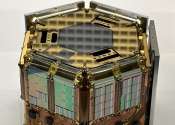Outflows from baby star affect nearby star formation
Baby stars don't always play nice with their siblings. New observations show an outflow of high-speed gas from one baby star colliding with a nearby dense cloud of gas where other stars are in the process of being born. These ...









